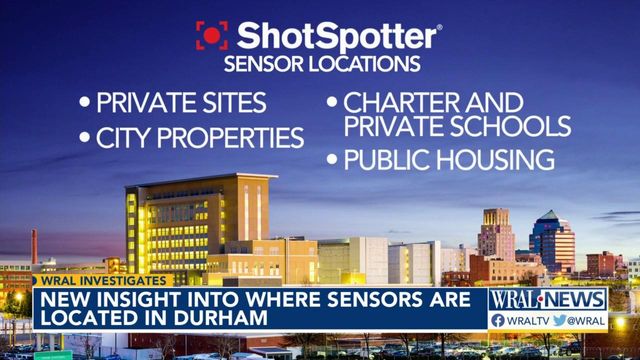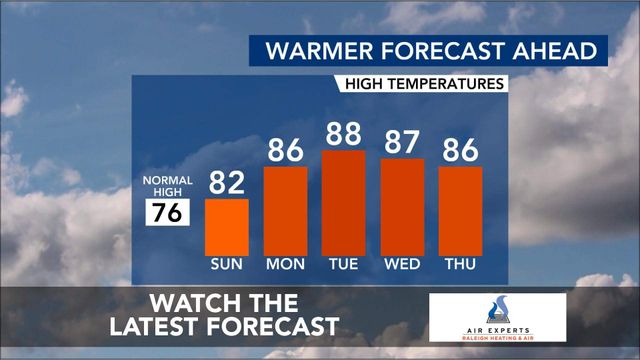Emails show where Durham has installed ShotSpotter sensors
Internal emails obtained by WRAL Investigates provide new insight into where gunshot detection company ShotSpotter placed its sensors in the city of Durham.
November 2022 emails between Durham Police Chief Patrice Andrews, city employees and ShotSpotter representatives also explain why the rollout of the controversial technology got delayed for months in the Bull City.
The November emails detail the general categories of the 77 locations of ShotSpotter sensors, which include individual homes and school buildings.

As of Nov. 7, the Durham Police Department had gotten permission to place cameras in 71 out of 77 locations, according to the emails:
- Private sites: 40/45 (98%)
- Public housing 4/5 (80%)
- City properties: 6/6 (100%)
- County properties 3/3 (100%)
- Duke Energy poles: 9/9 (100%)
- Other poles: 3/3 (100%)
- Charter/private school 6/6 (100%)
As of Nov. 7, Durham police had installed 45 out of the possible 77 sensors, according to the emails:
- Private sites: 30/45 (67%)
- Public housing 4/5 (80%)
- City properties: 6/6 (100%)
- County properties 0/3 (0%)
- Duke poles: 0/9 (0%)
- Other poles: 0/3 (0%)
- Charter/private school 5/6 (83%)

Community leaders explain why they approved ShotSpotter sensors
Durham Housing Authority CEO Anthony Scott says he signed off on the sensors because residents are eager for solutions to crime. He said he doesn’t know exactly where ShotSpotter installed its sensors.
“Every single community meeting or engagement that I had, when people found about it, were like, ‘Yeah, we definitely want that here,’” Scott said.
At least 20 people were shot in January in Durham, with 96 shootings reported overall since the start of 2023 – a higher number than the previous two years.
Scott said he has not heard any complaints or concerns from residents about the implementation of ShotSpotter.
“The focus has been more on the concerns of safety and being able to give the police whatever assistance they need to be able to better implement safety,” Scott said.
Ashley Canady is the resident council president for the McDougald Terrace public housing complex.
“It is beneficial because a lot of people don't want to call the police because they ask too many questions,” Canady said.
Duke Energy spokesperson Jeff Brooks said the company has a program to allow third parties to lease space on its utility and lighting poles to attach equipment.
“This might include phone and internet lines, signage and other applications including, in some instances, security equipment,” Brooks wrote in an email to WRAL Investigates. “Attachments must be approved by Duke Energy and cannot interfere with the safe and reliable operation of our power lines or equipment. “
Emails show specific addresses where ShotSpotter wanted to put sensors, including Maureen Joy Charter School, the Durham Police Department headquarters, KIPP Durham College Prep Public School, Global Scholars Academy, Durham County Board of Education, Durham County EMS, the Durham County Courthouse parking lot and the Department of Public Health.
It’s unclear whether these sites approved the ShotSpotter sensors.
A North Carolina Central University spokesperson confirmed that the university granted approval for ShotSpotter, and there are multiple sensors on campus.
Why the ShotSpotter pilot program got delayed in Durham
Other records WRAL Investigates obtained show as they sought approvals for sensors, ShotSpotter wanted Durham police officers to go with them, to add “safety” and “legitimacy.”
The November emails indicated Durham police did not do that, the first city not to, according to ShotSpotter. The gun technology is used in more than 135 cities throughout the country. The company’s representatives feared not having police officers with its employees would delay the launch.
The emails detail another hurdle ShotSpotter faced.
After the Durham Public Schools' Board said in September 2022 it would not allow sensors on DPS buildings, a ShotSpotter representative wrote to Andrews:
“We lost five permissions last week,” the representative wrote. “The school board decision has caused some property owners to rethink, and in some cases, rescind their agreement.”
In an email to Deputy City Manager Bo Ferguson, Andrews wrote, “Sad to me that DPS did not even reach out to us to ask questions about how we were going to responsibly pilot the technology, and that the technology could potentially warn us about an active shooter long before the first 911 call is made.”
ShotSpotter’s rollout in Durham was delayed multiple times. It finally launched in mid-December in a three-square mile area of the city.
The Durham Police Department publishes a dashboard with data. In January and February combined, the dashboard shows the sensors detected roughly 1,500 gunshots. That’s about 25 per day.
Durham’s pilot program for ShotSpotter is due to run for one year.














